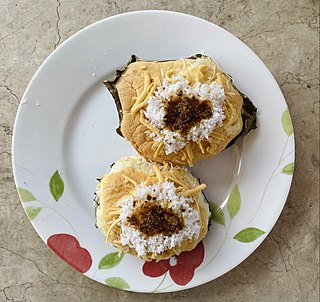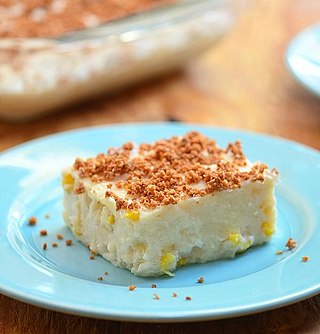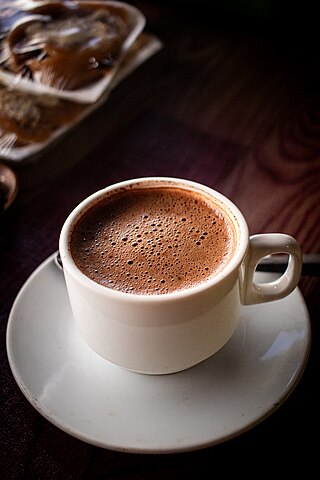
Glutinous rice is a type of rice grown mainly in Southeast and East Asia, and the northeastern regions of South Asia, which has opaque grains, very low amylose content, and is especially sticky when cooked. It is widely consumed across Asia.

Filipino cuisine is composed of the cuisines of more than a hundred distinct ethnolinguistic groups found throughout the Philippine archipelago. A majority of mainstream Filipino dishes that compose Filipino cuisine are from the food traditions of various ethnolinguistic groups and tribes of the archipelago, including the Ilocano, Pangasinan, Kapampangan, Tagalog, Bicolano, Visayan, Chavacano, and Maranao ethnolinguistic groups. The dishes associated with these groups evolved over the centuries from a largely indigenous base shared with maritime Southeast Asia with varied influences from Chinese, Spanish, and American cuisines, in line with the major waves of influence that had enriched the cultures of the archipelago, and adapted using indigenous ingredients to meet local preferences.

Bibingka commonly refers to a type of baked rice cake from the Philippines that is traditionally cooked in a terracotta oven lined with banana leaves and is usually eaten for breakfast or as merienda especially during the Christmas season. It is also known as bingka in the Visayas and Mindanao islands.

A rice cake may be any kind of food item made from rice that has been shaped, condensed, or otherwise combined into a single object. A wide variety of rice cakes exist in many different cultures in which rice is eaten. Common variations include cakes made with rice flour, those made from ground rice, and those made from whole grains of rice compressed together or combined with some other binding substance.

Suman, or budbud, is an elongated rice cake originating in the Philippines. It is made from glutinous rice cooked in coconut milk, often wrapped in banana leaves, coconut leaves, or buli or buri palm (Corypha) leaves for steaming. It is usually eaten sprinkled with sugar or laden with latik. A widespread variant of suman uses cassava instead of glutinous rice.

Kalamay is a sticky sweet delicacy that is popular in many regions of the Philippines. It is made of coconut milk, brown sugar, and ground glutinous rice. It can also be flavored with margarine, peanut butter, or vanilla. Kalamay can be eaten alone; but is usually used as a sweetener for a number of Filipino desserts and beverages. It is related to the Chamorro dessert called Kalamai.

Puto is a Filipino steamed rice cake, traditionally made from slightly fermented rice dough (galapong). It is eaten as is or as an accompaniment to a number of savoury dishes. Puto is also an umbrella term for various kinds of indigenous steamed cakes, including those made without rice. It is a sub-type of kakanin.

Latík refers to two different coconut-based ingredients in Filipino cuisine. In the Visayan region it refers to a syrupy caramelized coconut cream used as a dessert sauce. In the northern Philippines, it refers to solid byproducts of coconut oil production, used as garnishing for a variety of desserts.

Maja blanca is a Filipino dessert with a gelatin-like consistency made primarily from coconut milk. Also known as coconut pudding, it is usually served during fiestas and during the holidays, especially Christmas.

Puto seco, also known as puto masa, are Filipino cookies made from ground glutinous rice, cornstarch, sugar, salt, butter, and eggs. They are characteristically white and often shaped into thick disks. They have a dry, powdery texture.

Pichi-pichi, also spelled pitsi-pitsi, is a Filipino dessert made from steamed cassava flour balls mixed with sugar and lye. It is also commonly flavored with pandan leaves. It is served rolled in freshly grated coconut, cheese, or latik before serving.

Filipino American cuisine has been present in America ever since Filipinos moved there, but only recently has the Filipino food become more widely popular. Filipino food has gone through its evolution of adapting other cultures' food practices into their own, or borrowing the food concept into their own.

In Filipino cuisine, moron is a rice cake similar to suman. It is a native delicacy of the Waray people in the Eastern Visayas region of the Philippines, particularly in the area around Tacloban City in the province of Leyte and in Eastern Samar province. Other parts of the Philippines have their versions of it, however. In fact, the moron was adopted as one of Mambajao, Camiguin's locally produced products.
Mache or matse are glutinous rice balls originally plain or flavored with coconut and pandan from the province of Laguna, Philippines. It is made from boiled galapong usually plain or with pandan flavoring. It is then filled with toasted sesame seeds and sugar and rolled in more glutinous rice flour or powdered sugar for more sweetness. The resulting dish is characteristically white in color or green due to the pandan extracts.

Puto bumbong is a Filipino purple rice cake steamed in bamboo tubes. It is traditionally sold during the Christmas season. It is a type of puto.

Tsokolate, also spelled chocolate, is a native Filipino thick hot chocolate drink. It is made from tabliya or tablea, tablets of pure ground roasted cacao beans, dissolved in water and milk. Like in Spanish and Mexican versions of hot chocolate, the drink is traditionally made in a tsokolatera and briskly mixed with a wooden baton called the molinillo, causing the drink to be characteristically frothy. Tsokolate is typically sweetened with a bit of muscovado sugar, and has a distinctive grainy texture.
Sayongsong is a traditional Filipino steamed rice cake from Surigao del Norte and other areas of the Caraga Region of northeastern Mindanao, as well as the southeastern Visayas where it is known as sarungsong or alisuso. It is distinctively served in cone-shaped banana leaves. Sayongsong is a type of puto.

Ube cake is a traditional Filipino chiffon cake or sponge cake made with ube halaya. It is distinctively vividly purple in color, like most dishes made with ube in the Philippines.

Tupig, also known as intemtem or kangkanen, is a Filipino rice cake originating from northwestern Luzon, particularly the regions of Pangasinan, Tarlac, and Ilocos. It is made from ground slightly-fermented soaked glutinous rice (galapong) mixed with coconut milk, muscovado sugar, and young coconut (buko) strips. It is wrapped into a cylindrical form in banana leaves and baked directly on charcoal, with frequent turning. The name tupig means "flattened", in reference to its shape after cooking. It is popularly sold as street food in Pangasinan, particularly during the Christmas season. It is typically eaten with ginger tea (salabat).


















